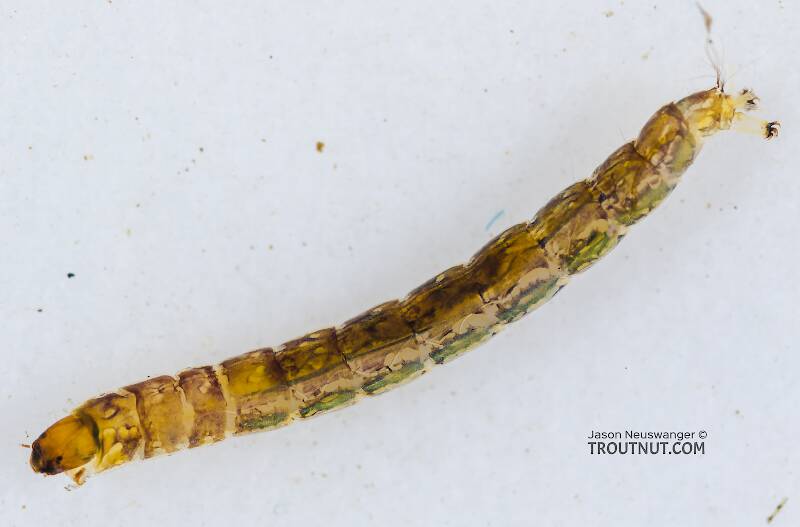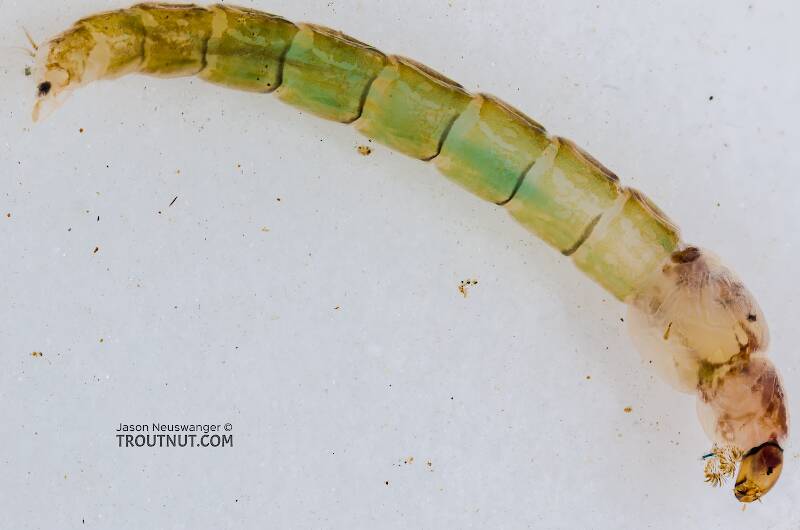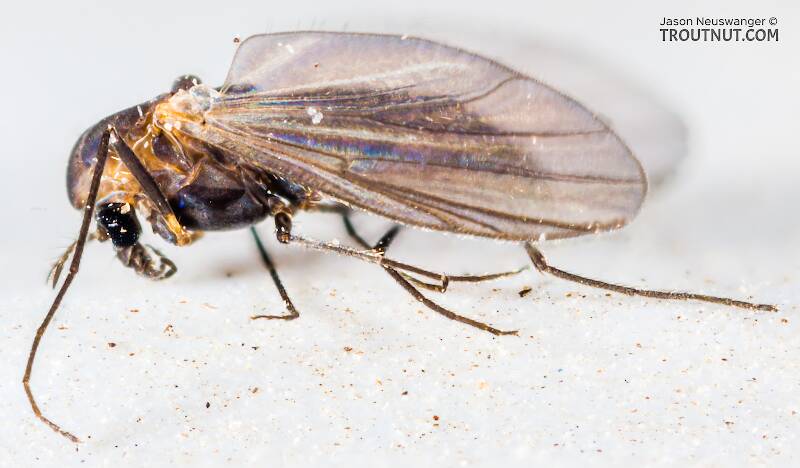
Hex Mayflies
Hexagenia limbata
The famous nocturnal Hex hatch of the Midwest (and a few other lucky locations) stirs to the surface mythically large brown trout that only touch streamers for the rest of the year.
Featured on the forum

Troutnut is a project started in 2003 by salmonid ecologist Jason "Troutnut" Neuswanger to help anglers and
fly tyers unabashedly embrace the entomological side of the sport. Learn more about Troutnut or
support the project for an enhanced experience here.
This topic is about the True Fly Family Chironomidae
Midges are the most important aquatic insects in some places, especially fertile spring creeks where they are extremely abundant and the current is so slow that it's efficient for trout to surface feed on very tiny insects.Some midges are large, up to hook size 14, but the majority are size 22 or smaller. The number of genera and species is hopelessly huge for angler entomologists to ever learn, and the identifing characteristics often require slide-mounting tiny parts under high-powered microscopes. Even the most Latin-minded fisherman must slip back to the basics--size and color--to describe his local midge hatches.
Example specimens
Troutnut on Apr 10, 2007April 10th, 2007, 6:20 pm EDT
This is a spin-off from a tangent in another topic which seems worthy of its own thread.
I wrote about the midge I photographed:
Gonzo replied:
Those are the explanations I've heard, too, but I'm skeptical of both. I'm not doubting the effectiveness of the Griffith's Gnat; I just think people have traditionally stretched the bounds of credibility when trying to explain a fly's success in imitative terms, and this is one of the more prominent examples.
Has anybody here seen a cluster of midges on the water? I haven't. I have seen midges thickly grouped on rocks next to the water, and I don't doubt that they occasionally fall off of there, and probably sometimes two are three are clinging to each other. I've also seen early-season stoneflies balled up with each other in an opaque little (presumably mating-related) clump on a midstream boulder, and I wouldn't be surprised if some midge species do something like that too. But trout don't see balls of midges floating around very often on any stream I've ever observed. Has anyone experienced that?
In either case, I can't see something so opaque as a Griffith's Gnat effectively imitating what would surely be a loose ball of gangly entangled midges. You would have to roll them around in your fingers for a while to goo them together so solidly.
I just can't see the herl and hackle imitating, or even suggesting, a loosening pupal shuck. Shucks don't get that loose. They trail behind length-wise; they don't balloon to the sides. And they aren't pointy. Of course I'm sure Schwiebert knows all that and was just trying to add an idea to the mix of explanations, but I do find that one as far-fetched as the others.
Here's another far-fetched guess: maybe the hackle and refractive trickery in the surface film reduce the perceived thickness of the fly and it passes for a single midge pretty well. This could be tested in an aquarium but it's late and I'm feeling lazy.
I think it's more likely that when trout take a Griffith's Gnat they're only looking for (at most) the right general size and color. It's not as fun, but sometimes things are really that simple.
I wrote about the midge I photographed:
I'm not sure how a griffith's gnat is supposed to imitate such a thing
Gonzo replied:
Schwiebert's theory was that when it was awash in the film, the herl and halo of hackle suggested the loosening pupal shuck around the dark body of the emerging midge. Others have speculated that it imitates a cluster of midges. Both theories are reasonable, I suppose, depending on the size of the Griffith's Gnat that is effective relative to the size of the actual midge. Like many anglers, I just know that it does work. :)
Those are the explanations I've heard, too, but I'm skeptical of both. I'm not doubting the effectiveness of the Griffith's Gnat; I just think people have traditionally stretched the bounds of credibility when trying to explain a fly's success in imitative terms, and this is one of the more prominent examples.
Has anybody here seen a cluster of midges on the water? I haven't. I have seen midges thickly grouped on rocks next to the water, and I don't doubt that they occasionally fall off of there, and probably sometimes two are three are clinging to each other. I've also seen early-season stoneflies balled up with each other in an opaque little (presumably mating-related) clump on a midstream boulder, and I wouldn't be surprised if some midge species do something like that too. But trout don't see balls of midges floating around very often on any stream I've ever observed. Has anyone experienced that?
In either case, I can't see something so opaque as a Griffith's Gnat effectively imitating what would surely be a loose ball of gangly entangled midges. You would have to roll them around in your fingers for a while to goo them together so solidly.
I just can't see the herl and hackle imitating, or even suggesting, a loosening pupal shuck. Shucks don't get that loose. They trail behind length-wise; they don't balloon to the sides. And they aren't pointy. Of course I'm sure Schwiebert knows all that and was just trying to add an idea to the mix of explanations, but I do find that one as far-fetched as the others.
Here's another far-fetched guess: maybe the hackle and refractive trickery in the surface film reduce the perceived thickness of the fly and it passes for a single midge pretty well. This could be tested in an aquarium but it's late and I'm feeling lazy.
I think it's more likely that when trout take a Griffith's Gnat they're only looking for (at most) the right general size and color. It's not as fun, but sometimes things are really that simple.
Jason Neuswanger, Ph.D.
Troutnut and salmonid ecologist
Troutnut and salmonid ecologist
GONZO on Apr 11, 2007April 11th, 2007, 6:03 am EDT
The only time I can clearly recall seeing clusters of midges on the water was on the Provo River, UT in late winter. All of the hatching/feeding activity was in slow side channels and backwaters, but we did have a "ball" fishing Griffith's Gnats over some BIG browns and rainbows.
Personally, I think that a heavy accumulation of emerging midges presents a fairly confusing picture to the trout. So much so that no focus on a single clean or consistent image is warranted (or perhaps even possible). Likewise, no easy explanation of a successful imitation is discernable. Heck, sometimes the fish just open their mouths and engulf midges en masse.
I have also always believed that the smaller the prey (and the smaller the imitation), the less the details matter--to the fish or the fly-tier.
Personally, I think that a heavy accumulation of emerging midges presents a fairly confusing picture to the trout. So much so that no focus on a single clean or consistent image is warranted (or perhaps even possible). Likewise, no easy explanation of a successful imitation is discernable. Heck, sometimes the fish just open their mouths and engulf midges en masse.
I have also always believed that the smaller the prey (and the smaller the imitation), the less the details matter--to the fish or the fly-tier.
Fishsage
Posts: 1
Posts: 1
Fishsage on Apr 11, 2007April 11th, 2007, 3:40 pm EDT
Hey Troutnut, first just wanted to say what a great site you have. Awesome pictures. I just found it yesterday. I just got back from fishing a great midge hatch in Montana for 4 days and the water was covered with them. On the cloudy and snowy days the fish were up on them. Midges do ball up into clusters on open water and the Griffith's Gnat has been my pattern of choice for many years. In calm water close to shore the natuarals do clump and don't move much. I think the fly does represent a cluster well and if you watch the single adults on open water they are not static. They "hover" and dart around on the surface and their wings beat very rapidly. I think it is this motion that may give the naturals a more robust apperance than they actually have and may be why the G.G., with its peacock body and hackle works so well. So in the right size and with decent presentation it usually gets em.
Ejreams on Jul 14, 2008July 14th, 2008, 9:21 am EDT
I think the griffith's gnat is suppose to resemble a collection of "gnats" "midges" or other small flies together on the surface, usually in the act of mating.
That's what I've heard anyways, it sure does work sometimes though, whatever it looks like i'll fish it :)
That's what I've heard anyways, it sure does work sometimes though, whatever it looks like i'll fish it :)
Ephemeral on Jan 17, 2009January 17th, 2009, 3:14 pm EST
FWIW-
I have seen midges cluster. Today as a matter of fact. It only happens when there is a blanket hatch of Chironomids which usually doesn't happen until the cold snap ends in mid January. I took a nice bow today on a gnat that was a good two sizes larger than the natural. This particular fish keyed on clusters of three or more midges.
I have seen midges cluster. Today as a matter of fact. It only happens when there is a blanket hatch of Chironomids which usually doesn't happen until the cold snap ends in mid January. I took a nice bow today on a gnat that was a good two sizes larger than the natural. This particular fish keyed on clusters of three or more midges.
Martinlf on Jan 20, 2009January 20th, 2009, 6:13 am EST
Is midge clustering vs. no clustering an east/west thing? I've never seen midges cluster up during or after a hatch, but have heard and read about this in descriptions of western waters and their hatches. I note those describing clustering in this thread are talking about western waters. Any Easterners familiar with the phenomena of midge clustering in streams this side of the Continental Divide?
"He spread them a yard and a half. 'And every one that got away is this big.'"
--Fred Chappell
--Fred Chappell
Shawnny3 on Jan 20, 2009January 20th, 2009, 11:29 pm EST
Just one more example of everything being bigger out West...
-Shawn
-Shawn
Jewelry-Quality Artistic Salmon Flies, by Shawn Davis
www.davisflydesigns.com
www.davisflydesigns.com
Trc101
Posts: 1
Posts: 1
Trc101 on Feb 28, 2009February 28th, 2009, 12:16 pm EST
Oh yes I have seen clusters of Midges on the San Juan river in New Mexico. They looked very simular to a Griffith's Gnat. I think you will find that on any cold tailwater that is loaded with Midges.
OMG
Posts: 8
Posts: 8
OMG on Mar 4, 2009March 4th, 2009, 1:49 pm EST
Hello guys,I would like to know what midge I observed on the "Saucon Creek" in mid February .Very tiny,3-4 mils,say a size28,stocky body,dun tent type wings same length as body.I managed to snatch one ,thought I might take it home,but lost it when I made the decision. Gave up to go watch a fellow named Barry flinging about the same size phony. He says "they are Mayflys".Well I had run into him several days b4,and we set a day later in the week to come back for more observation,and possibly fish those buggers,yaa I was suspicious about these "mayflys",but having talked all over the fishing spectrum I deduced that Barry was definitely well educated in this medium,[we burned up 2 hrs.]Anyway Barry was dropping names like the fortune 500 of flyfishermenso I figured,"when you are in the company of God" don't be an a'hole,keep your mouth shut and keep nodding,condidering my overrunnig mouth,I actually experienced peace and calm.But I'm still in the dark,so I'm asking " does anybody know "? Oh yaa,Barry was using a "Griffith's Gnat". OMG
OMG
Posts: 8
Posts: 8
OMG on Mar 4, 2009March 4th, 2009, 1:50 pm EST
Crap, I forgot ,the body/thorax was"BLACK".
Taxon on Mar 4, 2009March 4th, 2009, 3:48 pm EST
OMG-
When some fly fishers speak of a midge, they are simply referring to an extremely small adult aquatic insect. The other (probably more proper) usage of the term refers to certain families of order Diptera (True Flies).
You should be able to determine the order by just looking at the wings while the adult is at rest (as opposed to either in flight or expired) and the tails (if any).
Mayflies have wings which are held in a vertical (up) position, and have (either 2 or 3) tails.
Caddisflies have wings which rest on the abdomen in a tent-like fashion, extending beyond the end of the abdomen, and have no tails.
Stoneflies have wings which rest on the abdomen in a flat manner, and have 2 tails.
True Flies have wings which rest on the abdomen in a flat manner, and have no tails.
Hope this helps.
When some fly fishers speak of a midge, they are simply referring to an extremely small adult aquatic insect. The other (probably more proper) usage of the term refers to certain families of order Diptera (True Flies).
You should be able to determine the order by just looking at the wings while the adult is at rest (as opposed to either in flight or expired) and the tails (if any).
Mayflies have wings which are held in a vertical (up) position, and have (either 2 or 3) tails.
Caddisflies have wings which rest on the abdomen in a tent-like fashion, extending beyond the end of the abdomen, and have no tails.
Stoneflies have wings which rest on the abdomen in a flat manner, and have 2 tails.
True Flies have wings which rest on the abdomen in a flat manner, and have no tails.
Hope this helps.
OMG
Posts: 8
Posts: 8
OMG on Mar 10, 2009March 10th, 2009, 12:21 pm EDT
Taxon,thank you for the info. Yes I believe this insect was an caddis,just simply one of the midge variety.Unfortunately I,ve not been able to get back to the creek I mentioned ,to confirm. Alas time is of the essence,OMG.
DOS on Mar 18, 2009March 18th, 2009, 7:49 pm EDT
Just a quick observation from today... I spent several hours on a NY spring creek where the midges were so think you could not take a breath through the mouth without ingesting several dozen, however I did not witness any clustering. I had this thread in mind while I was doing my observing.
Andrew Nisbet
Bstrazer
Posts: 1
Posts: 1
Bstrazer on Nov 26, 2012November 26th, 2012, 8:13 am EST
I always thought that a Griffiths Gnat was a rotten imitation of an adult midge. However, I now understand the relationship. Fishing the high elevation reservoirs in Colorado, I have noted that certain midge species hatch then BUZZZZZ on the surface with rapid wing beats for a minute, or so, before flying off. The herl and hackle of the Griffiths Gnat imitate the "buzz" quite well. The fly works well in small sizes.
Entoman on Nov 26, 2012November 26th, 2012, 12:28 pm EST
Welcome to the forum, Bstrazer.
Anglers have long been analyzing this fly as to the reasons for its effectiveness. The rationale you offer certainly sounds good to me, along with many others I've heard over the years. All I know for sure is that there are times when it works very well during midge activity - and sometimes even when midges are nowhere to be seen.
Anglers have long been analyzing this fly as to the reasons for its effectiveness. The rationale you offer certainly sounds good to me, along with many others I've heard over the years. All I know for sure is that there are times when it works very well during midge activity - and sometimes even when midges are nowhere to be seen.
"It's not that I find fishing so important, it's just that I find all other endeavors of Man equally unimportant... And not nearly as much fun!" Robert Traver, Anatomy of a Fisherman
Oldredbarn on Nov 27, 2012November 27th, 2012, 2:31 pm EST
Anglers have long been analyzing this fly as to the reasons for its effectiveness. The rationale you offer certainly sounds good to me, along with many others I've heard over the years. All I know for sure is that there are times when it works very well during midge activity - and sometimes even when midges are nowhere to be seen.
Kurt,
...and sometimes, when it should be otherwise, not at all. :)
I agree with your reply here, but this is one of those times when I wish trout could only talk! My first question would be, "What do you take this for?!" We have all read about those theories of clusters of mating midges etc...Could it also be a small beetle or catapiller from below?
I decided to pull George Griffith's own, "For the Love of Trout" down from the bookshelf to see if he said anything there about it. I couldn't find much in the body of the book but there is a photo of him tying one.
There is also a clip of an article from "Michigan Out-of-Doors" a magazine of the Michigam United Conservation Clubs...It was called "The Fly Box" and each month there was a recipe for another fly and a little discussion of it...Griffith's book came out in 1993 so it was sometime before then.
"Griffith's Gnat" The following is from the article:
"July and August bring sun and heat to Michigan waters and hatches of our little summer midges or gnats. Fortunately, they don't bite as they come by the millions and trout gently suck in the emergers or the floating adult as he is drying.
George Griffith, one of the founders of Trout Unlimited, originally tied the fly, now carrying his name, to imitate the emerging midge. Gary Borger in his "Naturals" speaks of the Griffith's Gnat as the "finest imitation of emerging midges I've ever seen."
Hook: Mustad 94840 #18-22
Tail: None
Body: Peacock herl (may need 2-3 strands.
Wing: None
Hackle: Grizzly"
There you have it...Probably the first dry-fly any tier ties. :)
Spence
"Even when my best efforts fail it's a satisfying challenge, and that, after all, is the essence of fly fishing." -Chauncy Lively
"Envy not the man who lives beside the river, but the man the river flows through." Joseph T Heywood
"Envy not the man who lives beside the river, but the man the river flows through." Joseph T Heywood
Falsifly on Dec 3, 2012December 3rd, 2012, 3:41 pm EST
Gary Borger in his "Naturals" speaks of the Griffith's Gnat as the "finest imitation of emerging midges I've ever seen."
Lord knows I tried, but the Griffith's Gnat never proved any more than mediocre to me.
Falsifly
When asked what I just caught that monster on I showed him. He put on his magnifiers and said, "I can't believe they can see that."
When asked what I just caught that monster on I showed him. He put on his magnifiers and said, "I can't believe they can see that."
Entoman on Dec 3, 2012December 3rd, 2012, 9:17 pm EST
At many locations (especially the popular ones) it's now even less so, Allan. Analogous to "Yeah, the fishing was great there until it hit the fishing magazines ad nauseam"?
"It's not that I find fishing so important, it's just that I find all other endeavors of Man equally unimportant... And not nearly as much fun!" Robert Traver, Anatomy of a Fisherman
Gutcutter on Dec 4, 2012December 4th, 2012, 12:45 pm EST
At many locations (especially the popular ones) it's now even less so, Allan. Analogous to "Yeah, the fishing was great there until it hit the fishing magazines ad nauseam"?
Kurt-
Are you suggesting that the fish refuse a pattern that has worked because they see it too much, or that increased angling pressure causes fish to refuse previously successful patterns?
I'm with Allan on this. The 'Gnat has never been a terrific fly for me.
Maybe it's because I try and match the size and shade of the hatching midge, and I have those tiny patterns on the end of my tippet more than the usually larger 'Gnat.
Maybe it's because I use a finer and longer tippet with those size 26-30 patterns?
I have a dozen or so 'Gnats with me at all times, but I don't use them very often. I guess I use what works for me...
All men who fish may in turn be divided into two parts: those who fish for trout and those who don't. Trout fishermen are a race apart: they are a dedicated crew- indolent, improvident, and quietly mad.
-Robert Traver, Trout Madness
-Robert Traver, Trout Madness
Entoman on Dec 4, 2012December 4th, 2012, 7:48 pm EST
Are you suggesting that the fish refuse a pattern that has worked because they see it too much, or that increased angling pressure causes fish to refuse previously successful patterns?
Great question, Tony. I'm not sure... perhaps both to some degree? I just know that "hot" patterns seem to fade over time on heavily fished waters. I haven't used the fly in years on my most frequented rivers. Frankly, If I use it at all, it's as an "indicator with a hook in it" to suspend a tiny pupa when fishing stillwater. Can't remember the last time I had one on solo.
"It's not that I find fishing so important, it's just that I find all other endeavors of Man equally unimportant... And not nearly as much fun!" Robert Traver, Anatomy of a Fisherman
Quick Reply
Related Discussions
Topic
Replies
Last Reply
5
Jun 6, 2007
by Troutnut
by Troutnut
19
Jan 20, 2008
by Troutnut
by Troutnut
Re: First kayak fishing of the year - but again, the flowers outdid the fish 




In the Photography Board by Jmd123
+ 6





In the Photography Board by Jmd123
3
Jun 22, 2018
by Jmd123
by Jmd123












